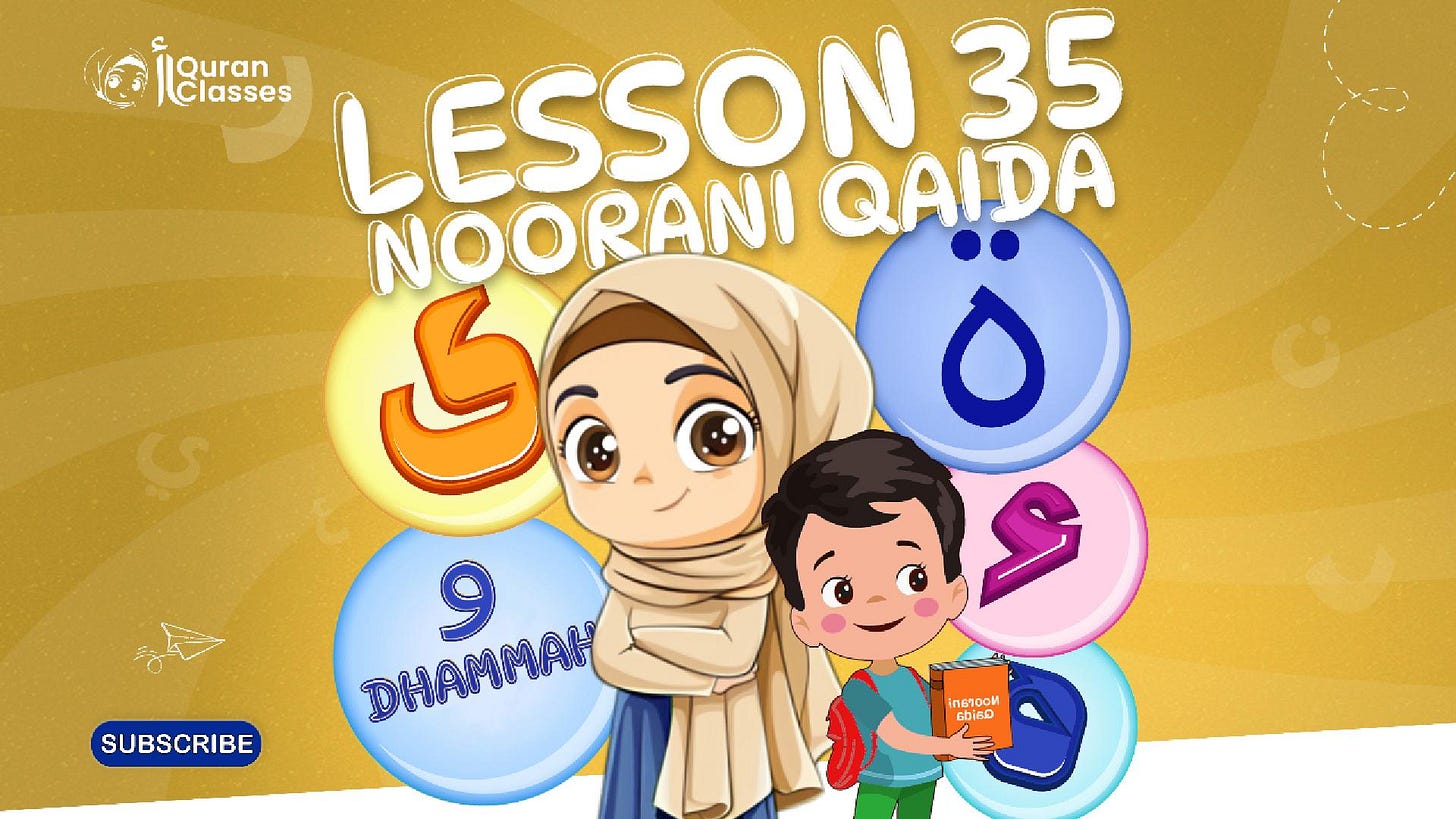Bayt Al-Quran: Noorani Qaida-Lesson#35| Friday
Soft Sounds, Strong Finish – هُ، ءُ، يُ، and ةُ with Dammah
And just like that — we’ve reached the final stop on our Dammah journey! 🎉 Today’s lesson wraps up this important vowel chapter with four gentle but essential sounds: هُ (Haa), ءُ (Hamza), يُ (Yaa), and ةُ (Taa Marbuta).
These letters are light on the tongue but heavy in meaning — often found in everyday Arabic words, beautiful Quranic expressions, and key vocabulary your child will encounter again and again. Whether it’s the whisper-soft هُ, the bold beginner ءُ, the melodic يُ, or the special rounded ةُ, today’s sounds are all about finesse and fluency.
As we celebrate this milestone, your child is not just learning sounds — they’re building the foundation of Arabic reading, connecting with the Quran one careful syllable at a time. This lesson is a gentle yet powerful reminder that every small sound counts — and every step forward is worth celebrating.
Ready to begin this final Dammah lesson together?
Key Learning Objectives
Recognize and pronounce the Arabic letters هُ, ءُ, يُ, and ةُ with the Dammah (ـُ) vowel correctly.
Understand how each of these sounds is formed in the mouth and throat, with a focus on clarity and roundness of the “oo” sound.
Develop familiarity with Hamza (ء) as a carrier of the Dammah sound at the beginning of words.
Learn the difference between Taa (ت) and Taa Marbuta (ة) when used with vowels.
Practice reading and reciting small combinations with these letters to improve fluency.
Strengthen letter-sound association for smooth transition into full word reading.
Celebrate completing the entire Dammah series — a major milestone in the Quranic reading journey!
🎥 Watch Today’s Lesson Video
Let’s Wrap Up Dammah with هُ، ءُ، يُ، and ةُ – Activity Time!
For our final Dammah lesson, we’ve created a playful and purposeful activity sheet that brings together the softness of هُ, the pop of ءُ, the flow of يُ, and the unique twist of ةُ — all in one colorful, engaging place.
This week’s sheet includes:
Tracing exercises to strengthen hand-eye coordination with these new shapes.
Sound-matching games to help your child associate each letter with the rounded Dammah sound.
Mini word puzzles and blends to gently ease them into recognizing these letters in early words.
Perfect for quiet practice or joyful review, this activity sheet is your child’s celebratory companion as they master the final Dammah sounds. So grab those crayons and a big smile — your child just completed a major milestone in their Quranic learning journey!
Playful Activities
🗣️ 1. “Whisper & Pop” Game
Each of these letters has a unique sound feel — so turn it into a sound game! Whisper هُ like a breeze, pop ءُ with energy, stretch يُ like a melody, and say ةُ like a soft bell. Let your child act out the sound with their voice and expression. It’s great for articulation and memory!
🎨 2. Dammah Art Dots
Draw the letters ه, ء, ي, and ة on paper (without vowels). Give your child stickers or dot markers to place a Dammah above each one as they say the sound out loud. It turns learning into art and repetition into fun!
🕵️ 3. Dammah Detective Search
Hide sticky notes with هُ, ءُ, يُ, and ةُ around the room. Give your child a magnifying glass or paper "detective badge." Each time they find one, they have to say the sound and use it in a mini word like هُدى, أُمّ, يُوسُف, or رَحْمَةُ.
We’d Love to Hear About This Final Dammah Milestone!
How did your little learner feel wrapping up the last of the Dammah letters today? Whether it was a proud grin tracing هُ, a giggle saying ءُ, or a confident moment reading يُ in a word — we’d be so happy to hear about it!
Feel free to share a short message, a photo of their worksheet, or even a quick video. Teacher Noura would love to celebrate this special moment and send a note of encouragement for all the amazing progress your child has made, inshaAllah.
With this lesson, your child has now completed all the Dammah vowel sounds — a huge milestone in their Quran reading journey! Your support, patience, and love have carried them through every letter, every sound, every page.
Keep going — the path of learning is lit beautifully by moments like these.



